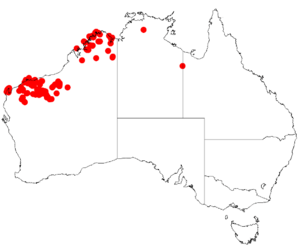Arid wattle facts for kids
Quick facts for kids Arid wattle |
|
|---|---|
| Scientific classification | |
| Genus: |
Acacia
|
| Species: |
arida
|
 |
|
| Occurrence data from AVH | |
Acacia arida, commonly known as the arid wattle or false melaleuca, is a type of shrub. It belongs to the large group of plants called Acacia, which are often known as wattles. This plant is native to Western Australia.
Contents
What Does the Arid Wattle Look Like?
The arid wattle is a shrub that usually grows between 0.9 and 3 meters (about 3 to 10 feet) tall. It has many thin stems that grow from its base. These stems can be up to 5 centimeters (2 inches) wide when the plant is fully grown. If there's a bushfire, new stems can grow back from underground parts or from the base of the plant.
The bark of the arid wattle is smooth and light grey. It becomes lighter in color towards the ends of the branches. The plant forms a soft, thick crown of delicate leaves.
Leaves and Flowers
The leaves of the arid wattle are called phyllodes. They are flat, not stiff, and stand upright. Each leaf is dull light green and measures about 2 to 8 centimeters (0.8 to 3.1 inches) long and 1 to 6 millimeters (0.04 to 0.24 inches) wide. They have a sweet, pleasant smell.
This wattle blooms from February to March or from July to August. It produces bright yellow flowers that grow in spikes. These flower spikes are scattered all over the plant and are about 10 to 30 millimeters (0.4 to 1.2 inches) long and 3 to 5 millimeters (0.12 to 0.20 inches) wide. The flowers are packed closely together on the spikes.
Seed Pods
After the flowers bloom, the plant forms seed pods. These pods are flat to somewhat square-shaped. They are about 3 to 8 centimeters (1.2 to 3.1 inches) long and 3 to 6 millimeters (0.12 to 0.24 inches) wide. The pods are stiff, woody, and range from yellow-brown to brown. They open up from the top to release their seeds and often have a slight hook shape.
How the Arid Wattle Got Its Name
The arid wattle was first officially described by a botanist named George Bentham in 1842. He wrote about it in a book called Notes on Mimoseae, with a synopsis of species.
Family Connections
A. arida is closely related to another wattle called Acacia orthocarpa. It is also related to Acacia arrecta. Scientists have even found a possible mix, or hybrid, of A. arida and Acacia stellaticeps near Roebourne.
Other Names
This plant has had a few other scientific names over time, which are called synonyms. These include Acacia trachycarpa, Racosperma aridum, and Acacia subrotata.
The name arida comes from the Latin word aridus, which means dry. This name was chosen because when the first plant sample was collected in 1819, it was noted as being from the "parched desert shores of Cambridge Gulf."
Where Does the Arid Wattle Grow?
The arid wattle is found in the Kimberley and Pilbara regions of Western Australia. It is spread out across the Pilbara area but usually doesn't make up most of the plants in one spot.
Habitat
However, the arid wattle can grow in thick groups on many hilltops. These hilltops are sometimes called sky islands. This is especially true in the Hamersley Range.
The plant grows in sandy soils or rocky soils. You can find it along shallow, temporary streams or on the slopes of hills. It also grows in red sandy loam or coarse, gravelly, sandy soils that are on top of laterite or sandstone. The arid wattle often grows as part of communities with spinifex grass or low, open Eucalypt trees.

